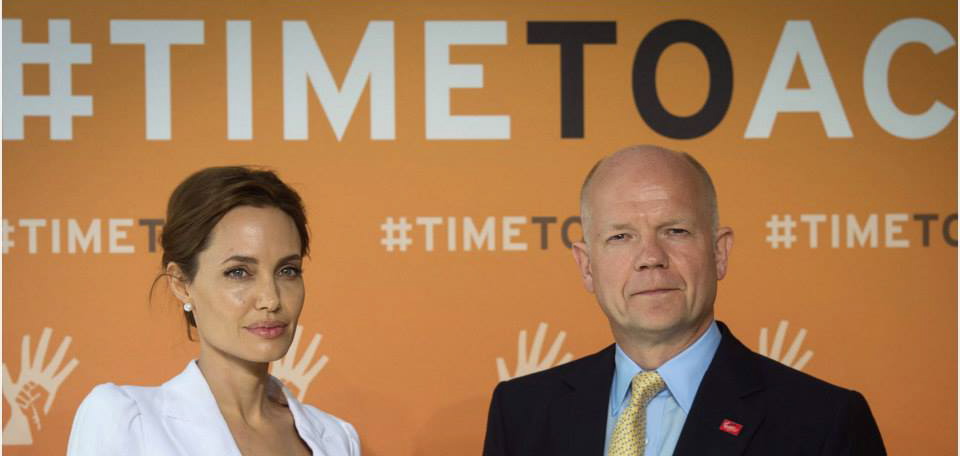Dispelling Four Myths about Sexual Violence in Conflict

At the Global Summit to End Sexual Violence in Conflict in London this week a number of myths about sexual violence have been debated and dispelled. Asia Pacific – the single largest global region – has been on the margins of this debate with the evidence base largely focusing on the Democratic Republic of the Congo (DRC), Syria, Central African Republic and Central America. However, this should not fool us into thinking that sexual violence is not an issue for the Asia-Pacific region as well.
Comparing the discussion in London with data collected on Sri Lanka shows the need to debunk further myths that can arise when we seek to correct conventional myths about the inevitability of sexual violence in conflict. We need to ask the when, how and why questions concerning sexual violence across a broader range of situations of political instability.
Myth #1: Sexual Violence in Conflict is Inevitable
Angelina Jolie stated at the Global Summit this week: “It’s a myth that rape is an inevitable part of conflict. It is a weapon of war”. The new International Protocol on the Documentation and Investigation of Sexual Violence in Conflict promises to facilitate the crucial evidence collection for national and international prosecutions of sexual violence crimes. The Protocol, which has the support of 148 countries that endorsed the UN Declaration of Commitment to End Sexual Violence in Conflict, is part of a broader package to introduce accountability for these crimes, reform the security and justice sectors to prosecute these crimes and support survivors. The power of this united statement is that provides a clear signal that there is no impunity for anyone that perpetrates or condones this violence.
Our message: There is no reason to doubt the potential power of a united global call to end sexual violence through building prohibitions around the acts. But we also need to think about the situations in which widespread and systematic sexual and gender-based violence (SGBV) occurs because of the desired political consequences from these acts. In these situations, the future prospect of prosecution may matter less than immediate short-term political gain.
In exploring the brutality that both the Sri Lankan armed forces and Tamil Tigers (LTTE) meted out to civilians in the last stages of a 30-year civil war, the UN Secretary-General’s Panel of Experts on Accountability in Sri Lanka found both sides had committed grave acts of sexual violence amounting to crimes against humanity and war crimes. This included the targeting of Tamil women for rape and sexual violence by Sri Lankan armed forces. A UN Human Rights Council resolution in March declared that the Sri Lankan government is failing in its responsibility to prosecute individuals for these crimes while the Office of the High Commissioner for Human Rights has been called upon to investigate allegations of war crimes and crimes against humanity committed by all parties during the civil war and, specifically, to address ongoing “violations of human rights in Sri Lanka, including SGBV”.
In the Sri Lanka case, we have to ask why SGBV is occurring and whether it is because of a failure to prosecute individuals for these crimes or just as importantly, because there are political structures that support and possibly encourage the commission of these crimes. This means we must pay greater attention to human rights violations, including those of women’s human rights defenders, and to minority groups, especially women and girls within those groups. We must also pay attention to the fact that widespread and systematic SGBV can occur outside of conflict: it can occur before the onset of war to intimidate and repress rebellion, as was attempted in Syria, or, as the Sri Lanka case reveals, sexual violence may persist – and indeed spike in even greater numbers – after the formal conflict ends.
Myth #2: Sexual Violence Affects Only Women and Girls
The Global Summit recognised that sexual violence affects men and boys also. Moreover, men and boys may be even less likely to report sexual violence due to ‘gendered’ stigma associated with being treated ‘like a woman’, which in many cultures is the ultimate form of degradation and subordination.
Our message: While sexual violence does not affect only women and girls, this fact should not detract from the ‘gendered’ nature of this violence where masculine dominance over ‘others’ through rape and other sexual violence is precisely intended to ‘feminise’ and shame victims, their families and communities. The mere sex disaggregation of victims by male/female does not explain when, how and why sexual violence is gender-based and committed with the intent to destroy.
In the Sri Lanka case the majority being subjected to SGBV were displaced persons. These individuals were predominantly female, including former Tamil combatants, and were extremely vulnerable due to political and economic restrictions on access to land rights, compensation, resources and income. Despite these vulnerabilities, Tamil women’s support groups have sought to assert their right to compensation and land, as well as demand investigations into family members in a way that is unprecedented in a ‘heavily patriarchal’ Sri Lanka society. It may not, therefore, be a coincidence that Tamil women in the post-conflict environment report experiencing extreme acts of sexual intimidation and violence upon their return by Sri Lankan military and police in a heavily policed security zone. Similarly, both male and female human rights defenders – as documented in claims for asylum – have reported persistent harassment, sexual torture under arrest and continued sexual intimidation and harassment after release. This suggests that in Sri Lanka, SGBV may be being used as a form of political violence to reestablish gender order and ethnic dominance, but we have little evidence on the ground – and few opportunities to receive reports on – the extent to which this violence may be widespread and systematic.
Myth #3: Rape is Used as an Intentional Weapon of War Through the Line of Command
This week the point has been made that rape in the DRC and Sierre Leone, for example, have by and large not been ordered by chief military commanders or officers. In dispelling the ‘rape as a weapon of war’ myth, sexual violence is reframed as opportunistic: it happens in social environments where there is a lack of discipline, fractured hierarchies and a normalisation of gender-based violence with strong masculine and feminine roles in that society. Sexual violence, understood in these terms, is not a ‘political’ act, nor even potentially an international security issue. As the 2012 Human Security Report dismissively suggested, “conflict-related sexual violence likely declines when the number and deadliness of conflicts declines.”
Our message: Sexual and gender-based violence may not always be ‘widespread and systematic’ under the criminal definition of Rome Statute. But we need significantly to improve our knowledge of when sexual violence is deployed as political violence, against whom, and why. The difficulty in prosecuting command and control responsibility for SGBV does not meant that widespread and systematic sexual violence has not occurred; the presence of widespread but not systematic SGBV, as may have been the the case in DRC and other African conflicts, does not mean this finding applies to all situations.
Analysis of the Sri Lanka conflict, particularly in the post-conflict period 2009-2013 , reveals a pattern of SGBV being used to intimidate and silence political opposition. The failure by the Sri Lankan Government to investigate these allegations reveals complicity, if not responsibility, for these crimes. At the same time, immediately after the end of conflict-related violence in 2009, there were reports of a general increase in domestic violence, prostitution, sex trafficking, forced marriage and sexual assault (by civilians) within the Northern Province. The existence of both types of sexual violence – opportunistic and political – within one situation is possible and should not diminish their gravity. Rather, different types of sexual violence may require different strategies of intervention and prevention.
Myth #4: Sexual Violence Occurs in All Conflicts
Researchers have cited evidence that sexual violence is not used by some armed groups, and indeed is not perpetrated in some conflicts in the world. They argue that this shows that sexual violence in conflict can be prevented: that it is specific to some perpetrator groups and relates to their tactics and socialisation techniques.
Our message: In the Sri Lanka case, it has been difficult to access independent reports of the activities and social culture of the LTTE. The Report of the UN Secretary-General’s Panel of Experts on Accountability in Sri Lanka found both sides had committed grave acts of sexual violence amounting to crimes against humanity and war crimes. The Report noted that both the Human Rights Watch and UN Special Representative for Children in Armed Conflict had concerns about the gendered forms of violence LTTE were committing to increase conscript numbers and coerce civilian support. Even if it is true that some rebel groups and militaries don’t ever perpetrate sexual violence, the findings produce policy recommendations that could be potentially misleading. In situations where sexual violence is ‘opportunistic’ then military training and socialisation may be effective, but in situations where SGBV is a gendered form of violent persecution to achieve political ends, socialisation and legal prosecution regimes may not work to prevent these crimes.
Gender Equality is the Goal
Political and social engagement with the prevention of sexual violence in armed conflict globally would not have happened without the personal commitment of UK Secretary of State for Foreign and Commonwealth Affairs William Hague and UNHCR Special Envoy Angelina Jolie. Debunking the myth that sexual violence is inevitable in any situation has the potential to empower gender equality – but the first goal will not happen without addressing the second. Sexual violence is almost always gender-based, is frequently politically-motivated, can be widespread and systematic outside of conflict and is often committed with the intent to destroy, irrespective of prohibition norms. To prevent its occurrence means preventing the political and social conditions that give rise to these crimes in the first place.
Dr Sara Davies is Senior Research Fellow, Faculty of Law, QUT. Professor Jacqui True is a Professor in the Faculty of Arts, School of Social Sciences, Monash University. The authors thank Sara Meger for her research assistance.




